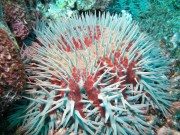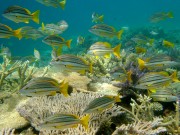James Kerry
Author of
Published on 18 January 2011

Extending over 2,000 km along the coast of Queensland, Australia and comprising some 2,900 individual coral reefs, the Great Barrier Reef [GBR] is the largest coral reef ecosystem to have existed in recent times. The northern most point of the GBR extends beyond Australian waters towards Papua New Guinea, whilst its southern most point terminates just north of Fraser Island off the south coast of Queensland. The width of the GBR varies along its length, extending from the low water mark on the Queensland coast past the edge of the continental shelf, and encompasses an entire area of approximately 344,400 square kilometres (133,000 sq mi), approximately the same size as Italy or Japan.
Published on 14 January 2011

Corals provide essential habitat structure and energy in coral reef systems, facilitating the existence of numerous reef associated species. Indo-Pacific coral reefs are home to over 600 species of hard corals (also called stony corals or scleractinian corals), and 4000-5000 species of reef fishes (Veron 2000, Lieske and Myers 2001). There are strong mutual dependencies between the reef-building corals and reef-inhabiting fishes, with many fish species depending on corals for food and habitat, while corals depend on the grazing by certain fishes for reproductive success. Even the spread of coral diseases may be mitigated by fishes. This article summarises what is known about these intricate mutual relationships.




